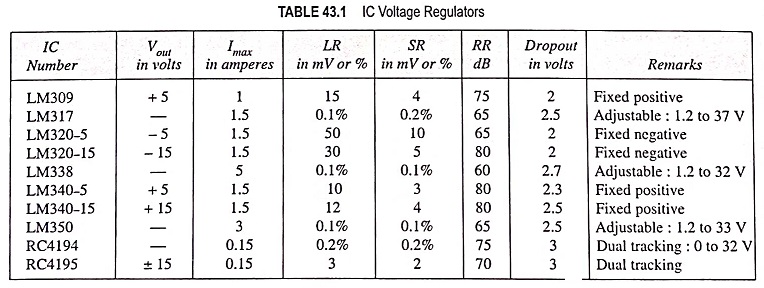IC Voltage Regulators:
IC voltage regulators are versatile and relatively inexpensive and are available with features such as a programmable output, current-voltage boosting, internal short-circuit current limiting, thermal shutdown, and floating operation for high voltage applications.
IC Voltage regulators comprise a class of widely employed ICs. Regulator IC units contain the circuitry for reference source, comparator amplifier, control device, and overload protection all in a single IC. Although the internal construction of IC is somewhat different from that explained in case of discrete voltage regulator circuits, the external operation is almost the same.
A power supply can be built using a transformer connected to the ac supply line to transform the ac voltage to a desired level, then rectifying the ac voltage, filtering with a capacitor and RC filter, if desired, and finally regulating the dc voltage employing an IC regulator. The regulators can be selected for operation with load currents ranging from hundreds of milliamperes to tens of amperes, corresponding to power ratings from milliwatts to tens of watts.
IC Voltage Regulators are of the following types:
- Fixed output voltage regulators: positive and/or negative output voltage.
- Adjustable output voltage regulators: positive or negative output voltage.
- Switching regulators.
- Special regulators.
Except for the switching regulators, all other types of regulators are linear regulators. The impedance of the active element of the linear regulator may be continuously varied to provide a desired current to the load. On the other hand, in a switching regulator a switch is turned on and off at a rate such that the regulator provides the desired average current in periodic pulses to the load. The switching regulators are more efficient than the linear regulators. This is because there is negligible power dissipation in switching elements in either the on or off state. Nevertheless, in switching regulators the power dissipation is substantial during the switching intervals (on to off or off to on). Also, most of the loads (devices) cannot accept the average current in periodic pulses. Therefore, most practical voltage regulators are of the linear type.
Voltage regulators, especially the switching type, are employed as control circuits in pulse width modulation, push-pull bridges, and series type switch mode supplies. Almost all power supplies make use of some type of voltage regulator IC because they are simple to use, reliable, cheaper in cost, and, above all, available in a variety of voltage and current ratings.
Table 43.1 lists data for some popular IC regulators. For instance, the LM 309 is a fixed positive regulator with an output of + 5 V, a maximum load current of 1 A, a load regulation of 15 mV, a source regulation of 4 mV, and a ripple rejection of 75 dB. For the adjustable regulators, LR and SR are given in percentage rather than millivolts. The table also includes the dropout voltage, or the minimum permissible difference between the input and output voltages. For example, an LM 309 has a dropout voltage of 2 V. It implies that the input voltage must be at least 2 V greater than output voltage i.e., input voltage must be at least 7 V, because its output voltage is 5 V.
